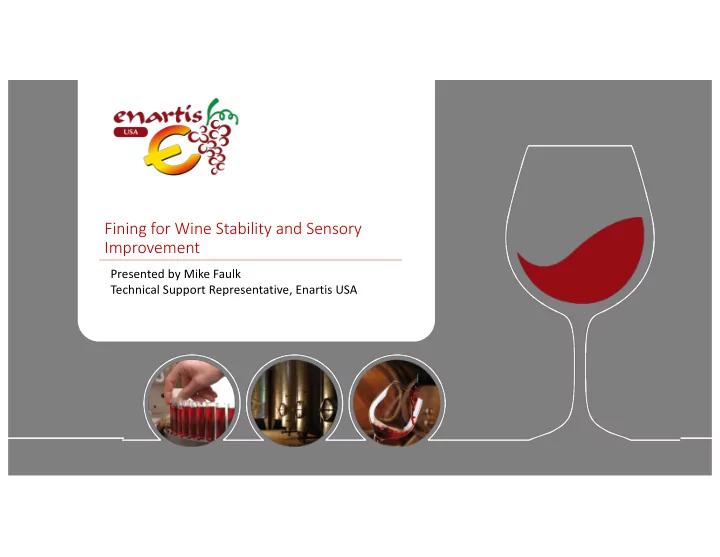

Fining for Wine Stability and Sensory Improvement Presented by Mike Faulk Technical Support Representative, Enartis USA
Overview • DeFined • Managing excessive tannin • Oxidation/ bitter phenolic fining • Metal removal • Off aroma / flavor removal • Protein fining / heat stability • Color modification
FINING Operation of adding one or more compounds (fining agents) into a wine/must to bind and/or remove another undesirable wine component(s) Purpose: Removal of excessive levels of certain wine components which contribute to sensory and stability issues
Premise of action Charged and hydrophilic /Soluble… Less charged, more hydrophobic/ Insoluble
Objectives of fining • Tannin management • Protein stability • Color adjustment (brown or red) • Bitter phenol reduction 20 40 80 � � � C C C • Unpleasant odors or flavors • Metal removal • Clarification • Filterability improvement
MANAGIN GING G EXCESSIV IVE TANNIN IN Press wines • Tannic varieties • Too much maceration time • • Unripe seed tannin
TANNIN IN + PROTEIN IN MECHANIS ISM Barak and Kennedy, J. Agric. Food Chem. 2013 , 61: 4270-4277.
TANNIC IC FIN ININ ING G –PROTEIN IN FIN ININ ING G AGE GENTS Tannin Removal efficiency -For clarification - Fish gelatin -For moderate - Gentle on -For aggressively primarily -Reduce dry structure tannin tannic wines -Highly effective tannin - Aged reds removal Eg. Press wines in juice - Whites/rose/ orange wines Clarification efficiency
Gelatin Characteristics PRODUCT CHARACTERISTICS EFFECTS APPLICATION HYDROCLAR VERY HYDROLYZED VERY EFFECTIVE IN REMOVING PRESSED WINES AVERAGE MW < 10.000 Da TANNIN (HIGH MW TANNIN) READY TO USE ALTERNATIVE TO 45 REDUCTION OF ASTRINGENCY IN ATOMIZED GELATIN THE FRONT PALATE HYDROCLAR MEDIUM HYDROLYZED GOOD EFFECTIVENESS IN SOFTENING OF YOUNG WINES AVERAGE MW <20.000 Da REMOVING TANNIN JUICE & WINE CLARIFICATION 30 GOOD EFFECTIVENESS IN (FLOTATION) CLARIFYING FINEGEL LITTLE HYDROLYZED QUITE GOOD EFFECTIVENESS IN JUICE & WINE CLARIFICATION AVERAGE MW < 50.000 Da CLARIFYING (FLOTATION) REDUCTION OF ASTRINGENCY IN REMOVAL OF HARD TANNINS THE MID & BACK PALATE ALTERNATIVE GELATIN OF PORCINE OR BOVINE ORIGIN HELPS WITH COLOR STABILIZATION CLARGEL LITTLE HYDROLYZED QUITE GOOD EFFECTIVENESS IN JUICE & WINE CLARIFICATION AVERAGE MW < 50.000 Da CLARIFYING (FLOTATION) REDUCTION OF ASTRINGENCY IN FINISHING TREATMENT OF AGED THE BACK PALATE WINES READY TO USE ALTERNATIVE TO WARM SOLUBLE GELATIN GOLDENCLAR VERY LITTLE HYDROLYZED VERY GOOD EFFECTIVENESS IN FINISHING TREATMENT OF AGED AVERAGE MW >100.000 Da CLARIFYING WINES LIGHTLY EFFECTIV IN REMOVING TANNINS
OXIDATIVE FINING O 2 PPO
OXIDATIVE FINING PVPP – Potassium Caseinate Potassium Caseinate, PVPP Polyvinylpolypyrrolidone -Milk protein Bentonite, Silica -Preventative for -Eliminates oxidation oxidation and off odors Best of both worlds! -Removes browned -Removes browning pigments -Removes oxidizable catechins -Removes bitterness
METALS INFLUENCE Oxidative reactions • Haze formation • • Legality (>.5 mg/L Cu)
METAL REMOVAL White wine Cu Reduction 2 1.8 1.6 1.4 1.2 Cu mg/L 1 0.8 0.6 PVI/PVP 0.4 Vinylimidizole vinylpyrollidone 0.2 0 Binds Cu, Fe, Al • Control 16 g/hL 32 g/hL Settles easily • Stabyl Met Dosages • Trials recommended
METAL REMOVAL Fe reduction 4 3.5 3 2.5 Fe mg/L 2 1.5 1 Pre-Activated Chitosan & PVI/PVP • 0.5 Binds Fe, Cu, Al • 0 • Settles easily Control Claril HM 20 g/hL Trials recommended •
OFF AROMA FINING: VOLATILE SULFUR H 2 S Mercaptans Disulfides CuSO 4 Bench Trials • Added as 1% liquid solution • • Mix tank under inert gas while Start at 5 g/hL dosage for trials adding, and add it slowly!
OFF AROMA FINING: MICROBIAL
OFF AROMA FINING: MICROBIAL Activated carbon Pre-Activated Chitosan - Low effect on color - Removes volatile phenols
PROTEIN STABILITY 20 � 40 80 � C � C C poll
BENTONITE TYPES NATURAL CALCIUM CALCIUM BENTONITE NATURAL SODIUM BENTONITE BENTONITE SODIUM ACTIVATED Expansion ++++ + ++ Reactivity with proteins ++++ ++ +++ Clarification ++ +++ +++
ENARTIS BENTONITE TOOLBOX CALCIUM BASED/ • SODIUM BASED • CALCIUM BASED/ CALCIUM BASED • • SODIUM ACTIVATED Highest protein SODIUM ACTIVATED Low protein • • absorption / lb Good protein • • Excellent protein absorption absorption • Most stripping absorption Excellent settling • Moderate settling • Good settling • • Excellent settling Low Dosage required • Less stripping •
DECOLORIZATION WITH ACTIVATED CARBON Consider: Type of Carbon • Contact time • Dosage • • BENCH TRIALS!
CARBON COLOR REMOVAL EFFICIENCY Hydrated form Best color less messy removal capacity
General rules for a good fining 1. Define the goal of fining (clarification , stabilization, sensory improvement etc) 2. Choose the fining agent that is the most effective to reach the goal: greater effectiveness = lower dosage 3. Run preliminary lab trials: every harvest is different! 4. All products are not the same. Try them and taste.
General rules for a good fining 5. Respect time, temperature & proportion in the preparation of fing agents, 6. Add fining agents into the wine very slowly 7. Assure a homogenous distribution
The End... Thank You Q&A
Recommend
More recommend